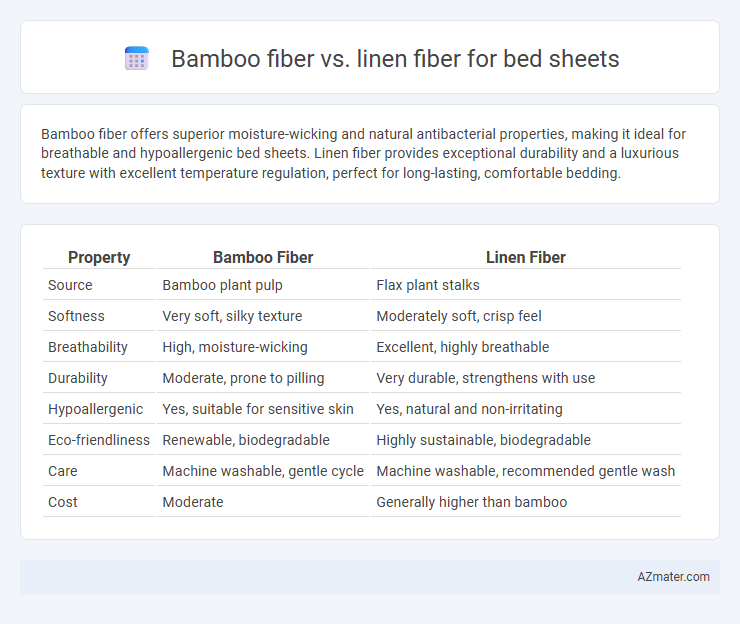Bamboo fiber offers superior moisture-wicking and natural antibacterial properties, making it ideal for breathable and hypoallergenic bed sheets. Linen fiber provides exceptional durability and a luxurious texture with excellent temperature regulation, perfect for long-lasting, comfortable bedding.
Table of Comparison
| Property | Bamboo Fiber | Linen Fiber |
|---|---|---|
| Source | Bamboo plant pulp | Flax plant stalks |
| Softness | Very soft, silky texture | Moderately soft, crisp feel |
| Breathability | High, moisture-wicking | Excellent, highly breathable |
| Durability | Moderate, prone to pilling | Very durable, strengthens with use |
| Hypoallergenic | Yes, suitable for sensitive skin | Yes, natural and non-irritating |
| Eco-friendliness | Renewable, biodegradable | Highly sustainable, biodegradable |
| Care | Machine washable, gentle cycle | Machine washable, recommended gentle wash |
| Cost | Moderate | Generally higher than bamboo |
Introduction to Bamboo Fiber and Linen Fiber
Bamboo fiber, derived from the pulp of bamboo grass, offers natural antibacterial properties, moisture-wicking abilities, and exceptional softness, making it ideal for breathable and eco-friendly bed sheets. Linen fiber, harvested from the flax plant, is celebrated for its durability, moisture absorbency, and temperature-regulating qualities, providing a crisp, textured feel that improves with each wash. Both fibers present sustainable alternatives to traditional cotton, with bamboo excelling in softness and bamboo and linen offering strong environmental benefits through reduced water usage and biodegradability.
Origin and Production Process
Bamboo fiber for bed sheets originates from the pulp of bamboo plants, processed through mechanical crushing or chemical treatment to extract viscose or lyocell fibers, offering a sustainable alternative with rapid renewability. Linen fiber derives from the flax plant, undergoing retting, drying, and scutching to separate fibers before spinning into yarn, known for its durability and breathability rooted in ancient textile traditions. The bamboo production process emphasizes eco-friendly methods with lower water usage, while linen production relies on agricultural cultivation with labor-intensive harvesting and fiber extraction techniques.
Environmental Impact and Sustainability
Bamboo fiber bed sheets offer a highly sustainable choice due to bamboo's rapid growth rate and minimal water requirements, significantly reducing environmental impact compared to traditional crops. Linen, derived from flax plants, also provides eco-friendly benefits with its low pesticide use and biodegradability, but it typically demands more water and labor-intensive harvesting processes than bamboo. Both fibers are biodegradable and breathable, making them preferable alternatives to synthetic fabrics, yet bamboo sheets generally have a lower overall carbon footprint and faster regeneration cycle.
Texture and Softness Comparison
Bamboo fiber bed sheets offer a silky-smooth texture with a natural sheen, providing a luxuriously soft and breathable feel that remains cool to the touch. Linen fiber sheets feature a slightly coarser texture with a crisp, airy finish that softens over time but maintains durability and moisture-wicking properties. Bamboo fibers excel in softness and smoothness from the start, while linen fibers prioritize texture resilience and gradual softness with repeated use.
Breathability and Temperature Regulation
Bamboo fiber offers superior breathability and excellent moisture-wicking properties, making it ideal for regulating temperature during sleep by keeping the body cool and dry. Linen fiber also excels in breathability due to its natural flax composition, which promotes air circulation and absorbs humidity effectively, providing a refreshing sleeping experience. Both fibers support temperature regulation, but bamboo's softer texture and enhanced moisture management make it particularly well-suited for those seeking optimal cooling and comfort in bed sheets.
Durability and Longevity
Bamboo fiber offers exceptional durability due to its natural strength and resistance to wear, making it an excellent choice for bed sheets that maintain softness over time. Linen fiber is renowned for its long-lasting quality, with fibers that become softer and stronger after each wash, ensuring extended longevity in bedding. Both materials provide durable options, but linen's resilience to pilling and natural breathability often result in longer-lasting bed sheets compared to bamboo fiber.
Moisture-Wicking and Hypoallergenic Properties
Bamboo fiber bed sheets excel in moisture-wicking due to their natural ability to draw sweat away from the skin, keeping sleepers dry and comfortable throughout the night. Linen fiber, made from flax plants, also offers excellent breathability and moisture-wicking properties but is often noted for its durability and cool feel. Both bamboo and linen fibers are hypoallergenic, making them ideal choices for sensitive skin, though bamboo's antimicrobial properties provide an added layer of protection against allergens and bacteria.
Care and Maintenance Requirements
Bamboo fiber bed sheets require gentle washing in cold water and air drying to maintain their softness and longevity, as high temperatures can cause shrinkage and damage fibers. Linen fiber bed sheets demand more rigorous care, including washing in warm water and possible ironing to preserve their crisp texture and durability. Both fibers benefit from avoiding bleach and fabric softeners to prevent fiber degradation, enhancing the lifespan of the bedding.
Cost and Value Analysis
Bamboo fiber bed sheets typically cost between $30 to $60 per set, offering eco-friendly benefits and natural antibacterial properties that enhance value despite a slightly higher price point compared to linen fibers. Linen sheets, ranging from $40 to $100 per set, provide superior durability and moisture-wicking capabilities, making them a long-term investment with increased lifespan and comfort. When analyzing cost versus value, bamboo sheets excel in affordability and sustainability, while linen offers premium durability and temperature regulation for higher upfront costs.
Conclusion: Which is Better for Bed Sheets?
Bamboo fiber offers superior moisture-wicking and antibacterial properties, making it excellent for hot sleepers and allergy sufferers, while linen fiber stands out for its exceptional durability and breathability, ideal for long-term use in varied climates. The choice depends on personal preferences: bamboo for softness and hypoallergenic comfort, linen for strength and natural texture. For a balance of sustainability, comfort, and longevity, bamboo fiber generally emerges as the better option for bed sheets.

Infographic: Bamboo fiber vs Linen fiber for Bed sheet
 azmater.com
azmater.com